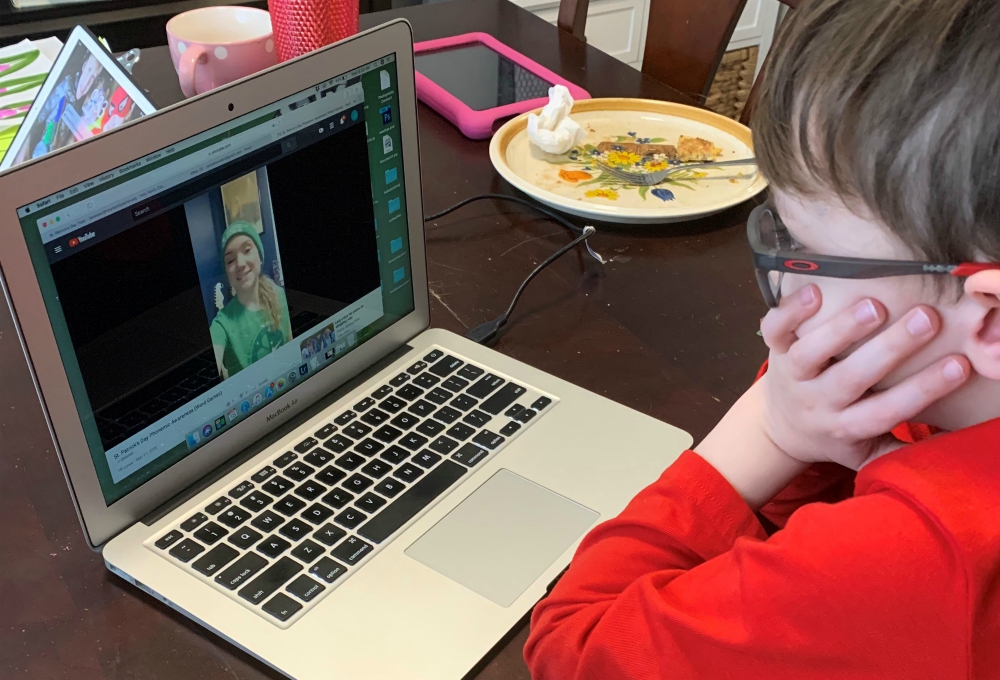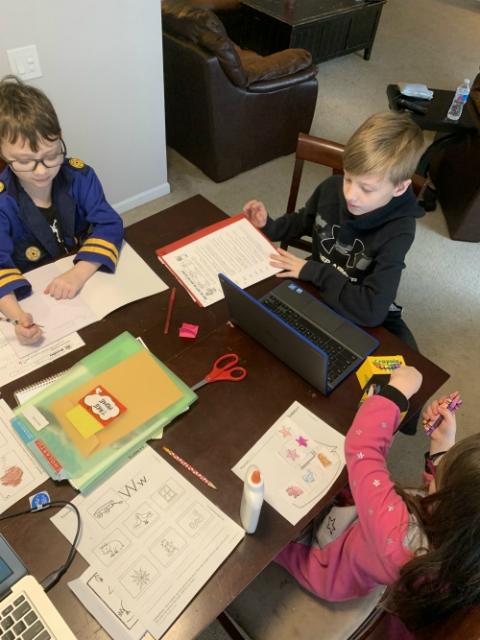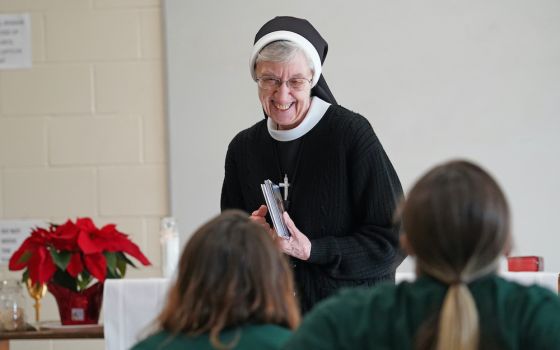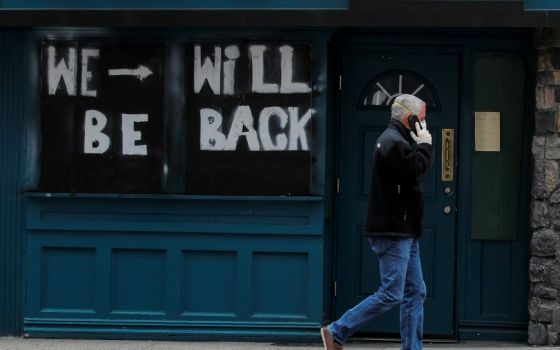
A teaser trailer for "Day of a Stranger," Cassidy Hall's documentary on Thomas Merton, features recordings of Merton's voice.
The morning of March 16 started like a typical school day for Jamie Breeden.
She woke up her three children and helped them get ready for the day. By 8:45, they joined their Holy Family Catholic Academy classmates in listening to their principal read the morning announcements and lead the morning prayer and Pledge of Allegiance.
It was a normal routine. Just not a normal setting.
Instead of being inside their classrooms at the elementary school in Iverness, Illinois, in the suburbs northwest of Chicago, the Breeden children watched Principal Catherine O'Brien livestreamed on a tablet placed on their dining room table. This was the new normal of e-learning at Holy Family and other schools across the Chicago Archdiocese in the wake of the global coronavirus outbreak.
Cardinal Blase Cupich announced March 13 all archdiocesan schools would shift to remote learning from home indefinitely. The archdiocese also confirmed a student at St. Margaret of Scotland School had tested positive for COVID-19, the disease caused by the novel coronavirus. That same day, Gov. J.B. Pritzker ordered all schools in Illinois to remain closed through March 30. Chicago's public schools already stretched their closure through April 20, and it's possible the statewide mandate could be extended, as well.
Illinois on March 20 became the latest state to direct residents to remain at home outside essential activities, with the order in place through April 7.
Jason Huther, principal at Carmel Catholic High School, in Mundelein, said they began preparing teachers for the possibility several weeks ago. "We didn't know that it was going to get here as quick," he told NCR on March 17.
"This is very different," Breeden said.

Jaxon, Avri and Brayden, students at Holy Family Catholic Academy, stand for the Pledge of Allegiance in their dining room and watch on a tablet their principal Catherine O'Brien (left) lead the school via Facebook Live outside her own home. The coronavirus outbreak has moved classes from the school building into the homes of students and teachers. (Jamie Breeden; Facebook screenshot)
Elementary e-learning
At Holy Academy, they had three school days to prepare for the new education reality. Luckily, they already had a plan in place.
In August, the archdiocese approved the school's emergency e-learning program for snow days, or days too cold to go to school, a common occurrence in Chicago. A relatively mild winter left school administrators thinking the plan would remain unused until maybe next year. Then the coronavirus began to spread rapidly across the U.S., and public gatherings, sporting events and schools quickly shut down in an effort to contain the contagion.
Rumblings of possible school closures began echoing on March 11. At a staff meeting that day, preparations for e-learning began in earnest.
"I think I was slightly surprised that it was happening so soon, but at the same time, I knew we could get it together," O'Brien told NCR in a phone interview March 17.
Two days later, O'Brien and assistant principal Laura Clark went room to room to inform students their classrooms would be temporarily closed, "that learning is going to look a little bit different this week." Some students asked if it was related to the virus. Others posed more immediate questions, like if they had to still wear their uniforms. (They did not.)
Students went home that day with their books and some with the notebook computers they already used in class. Teachers began prepping remote-friendly lesson plans for the following week. Holy Family alumni back from their own shuttered college campuses helped pack materials and make copies. Janice Geisheker, the technology coach, worked with teachers to familiarize themselves with Zoom conferencing and uploading coursework to class websites on Google Classroom — a platform for educators that many of third- through eighth-grade teachers have used throughout the year. The lower grades have a similar program.
Geisheker said she spent much of the weekend on the phone with teachers, training and troubleshooting. By the afternoon of the second day of e-learning, messages on her phone had already dwindled, a sign she took that teachers were becoming more comfortable with the digital tools.
"They just took off. It's been fabulous," she said.
In the first days of e-learning, teachers for younger grades shared videos of coloring and name-tracing. A Spanish teacher asked questions on a video and students responded. Even the art, music and P.E. teachers put together assignments. On St. Patrick's Day, Breeden, who is an assistant preschool teacher, uploaded a video to YouTube for the whole school of a science experiment making a rainbow from a mixture of hot water and Skittles. Along with other teachers, she's made numerous reading videos that students can follow along with at home. "We read a lot of books," she said.
"I was a little nervous at first," Breeden said of how e-learning might go. "But this is for the kids and all they want to do is see their teachers' faces. And I think just having fun on the video and making it short and sweet kind of helps parents out."
On the other side of the screen, Breeden's children are working away on their assignments. Avri, a kindergartner, and Jaxon, in second grade, sit at the table, as their mom helps take and upload photos of completed assignments to their teachers. Fifth-grader Brayden has worked mostly independently in his room.
Each of the children spend time each day completing lessons on a computer or tablet, as they would at school. So far, the internet connection has held strong. For the most part, the kids have followed a schedule akin to a normal school day, even notifying Breeden when it's the time they would take a break, get a snack and especially go to recess.
"There's been a good amount of work and a good amount of still fun things to do, and we've kept a really nice schedule," Breeden said.

Siblings Jazon, Avri and Brayden work on class assignments at the dining room table. (Jamie Breeden)
Parents, grandparents and caregivers are at home with the students, O'Brien said. She is, as well, making only a couple trips to the school to provide computers to parents of students who need them, and on Wednesday to deliver the morning announcements. Providing lunches hasn't been a need for students so far.
The principal has spent the week bouncing among virtual classrooms to see how remote learning is working. Fifth-grade students shared their likes and dislikes with their temporary home classrooms; among the dislikes: not being able to see their friends. Zoom meetings have helped some, and teachers have encouraged students to share photos from home that are compiled into a video at the end of the day, though O'Brien admits it's an imperfect substitute.
Still, students have found some positives, such as eating whenever the hunger strikes them.
"They love eating and staying in their pajamas," O'Brien said.
Throughout the week in classroom visits and morning announcements, the principal has repeated the school theme that starts each all-school Mass: "We are in this together." That past days have seen the school embody those words, teachers said, is a bright spot in a less-than-ideal situation. O'Brien called the first day of e-learning "probably one of the highlights of my career as a principal. It truly was."
Parents have thanked Holy Family staff for their preparedness, and as one eighth-grade parent stated, providing her daughter the comfort of a school routine amid a chaotic time. The mom of three Breeden agreed.
"It's nice that they still have this normalcy in their lives. I feel like they need that. And I feel like we're going to need that for the next few weeks."
High school chemistry without a lab
At the Borkowski household, Carmel Catholic students Nina and Tommy were bunkered all week in their bedrooms, their makeshift classrooms for the time being.
Tommy, a senior, had folders for each of his seven classes laid out on the floor. He worked through them one by one, following the structured schedule provided by his school. While Carmel students typically have four or five classes a day, now each is sectioned into 45-minute blocks every day.
"You spend a lot of time doing homework," he said, with AP physics and AP calculus among his course load.

For the time being, Tommy Borkowski's bedroom will double as his classroom, as the Chicago Archdiocese closed all school buildings in efforts to contain the spread of the coronavirus. A senior at Carmel Catholic High School, Borkowski said while e-learning has perks, he still prefers being at school with his friends. (Gina Borkowski)
In the room down the hall, his sister, Nina, worked through her slate of honors classes. Like everyone else, she's adjusting to the new format. Some teachers require students to join regular class meetings via video chat, others issue assignments on Google Classroom each morning to complete by that evening or the next day.
Nina prefers the video classes, like her math course, because she can ask questions directly and hear what her classmates are saying, "just like it would be in class normally." Her first online test was in chemistry, where her teacher, Michelle Titterton, hosted a Google Meet so students, along with using their notes, could chat and ask questions.
Teachers like Titterton have had to make adjustments, too. Along with online tests, she's had to rethink how to run chemistry labs without the lab. A cache of digital resources has eased the transition. Normalcy is the goal. Classes still begin with a short prayer, and she's placed a San Damiano cross in the background of her virtual workspace, just like it would be in her classroom.
"I still wanted that in the forefront. So we didn't forget it, right? In the midst of all this, let's not forget that," she told NCR.
As chair of the science department, Titterton helped shepherd her fellow teachers in prepping their virtual classrooms. The school has for several years used Google Classroom and provided students Chromebooks, which they could take home. Most textbooks have online materials, and numerous publishers have made resources available for free for the remainder of the school year. Her message to her department was simple: "Let's just keep classes going. Let's keep doing science, but realize that this is something new."
At a March 16 online staff department meeting, teachers decompressed after their first virtual day. Some, with decades of experience, felt exhaustion that recalled memories of their first day of teaching. But overall, learning continued without a glitch, save for a cat walking across the screen in one virtual class, to the delight of the students who quickly spread word of the moment — just like they would in school hallways.
So far, there have been no technology hiccups for the Borkowskis, either, though their mom, Gina, one day almost rebooted the internet modem, a modern update on the "my dog ate my homework" excuse.
Both Nina and Tommy agreed the workload seems larger than a typical school day, and wondered if they're actually absorbing the material. There's also a different type of self-discipline required and new distractions to tune out, whether it's the cellphone or the house sounds of Mom in the kitchen or the dog barking.
In Nina's English class, students were assigned to make videos of their opinion on e-learning. The early consensus? While they get the circumstances that make it necessary right now, they're eager to return to their classrooms.
"It is nice being able to be at home to do the work. There are those benefits," Tommy said. "But overall, I'd say I'd like being in school better, which is not something I thought I'd ever say."
The coronavirus outbreak has not just driven students homebound, it's ground the fast-paced, activity-loaded life of a student to a screeching halt. Gone are the sports games and recitals. Gone are the meetings and appointments. Gone are the countless other obligations on the calendar that filled the hours before and after the school day.
Prom, set for May 1, is on hold for now. The state canceled all high school spring sports, a big blow for Tommy as a senior on the tennis team. He's also uncertain if he'll be able to make final visits to potential college campuses, many of which are closed, before he has to make a decision.

Nina Borkowski, a sophomore at Carmel Catholic High School in Mundelein, Illinois, works on class assignments on top of her bed. The shift from classroom to bedroom came in response to the coronavirus outbreak that has closed schools and restaurants and canceled public events in an effort to contain the virus. (Gina Borkowski)
For Nina, the dance team schedule wrapped just before the coronavirus shutdown. But her cleared schedule has freed up time for other things.
"I've cleaned my room, and my mom's happy about that," she said.
It's also meant more family time, often a casualty to the busy life of a teenager. Earlier in the week, the Borkowski family watched a movie together. ("Tootsie," dad's pick.) Nina and her dad got in some driving hours on her learning permit on a noticeably less-congested expressway. They've gone on family walks. Their mom, while grieved for the impact of the cancellations on her children, has loved having them at the house. Being able to overhear Tommy work through a physics problem with a friend or Nina FaceTime with friends at lunch has opened a window into their school lives, a positive development from a bad situation.
"We're enjoying time. We're relaxing. We're not running here, running there," Gina Borkowski said.
How long will it last?
At both schools, Friday was the light at the end of the tunnel.
Spring break.
While most families' plans were likely canceled, the week off for students offered teachers and administrators time to regroup and assess how the e-learning has worked so far.
Part of the assessment will be how to help students manage their own learning should e-learning prolong beyond March 30.
Teachers always worry when students have extended time away from the classroom, the Carmel principal Huther said, and how they can keep all students on the same page. He has encouraged them to use videoconferencing more to check in on students, but also to give students that sense of community and relationship integral to the learning process.
Advertisement
As learning outside the classroom extends, excitement with the newness will eventually wear, said Geisheker, the technology coach at Holy Academy.
"It's a solution for what we need right now. We need to isolate people, and this is the best solution possible. Hopefully, it doesn't go on too long because I don't think this is a wave of the future where a student should always be learning this way," she said.
Teachers at Carmel see holding students to a structured schedule will help ingrain the discipline to maintain focus during uncertain times.
"We tell them that there's a lot of anxiety surrounding what's going on. Pretty much nothing is normal right now," Huther said. "So it's important to have at least something, some routine, that brings you back to that sense of normalcy."
Parents like Gina Borkowski and Michelle Titterton said they're thankful for any normalcy in their children's lives right now. Borkowski especially appreciated that Carmel jumped straight into e-learning, rather than using "Act of God" days, as have some schools in the area, that would have made it two weeks away from classes.
At Carmel, they are holding out hope that students can at some point return to the building. Count Huther among them, but he has difficulty seeing classes resuming before Easter, this year on April 12, if they resume at all. Contingency plans are already in the works for prom as well as what a virtual graduation might look like.
"It really depends on how this virus takes hold," he said, "if we've done enough to curve it over time. But I'd be lying if every principal weren't preparing for the rest of the year with no physical students in the building."
[Brian Roewe is an NCR staff writer. His email address is broewe@ncronline.org. Follow him on Twitter: @BrianRoewe.]







